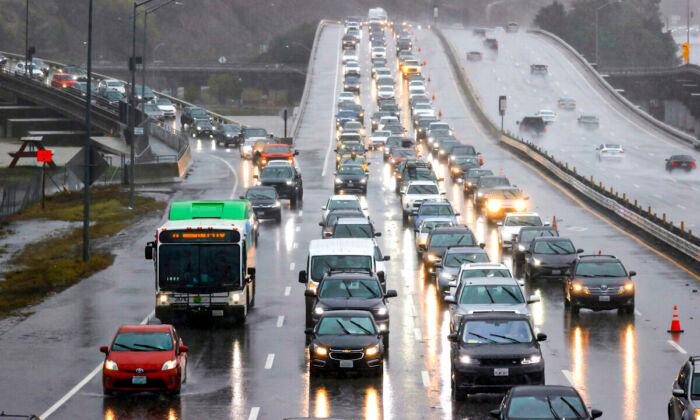The Biden administration on Wednesday proposed a new rule that would require nearly all passenger vehicles and light trucks to have automatic emergency brakes (AEB) before they are allowed on American roads.
The National Highway Traffic Safety Administration (NHTSA), which oversees safety standards for automakers in the United States, said the proposed rule would “dramatically” reduce the number of crashes with pedestrians and rear-end collisions.
In numbers, the federal agency estimated that implementing the rule could save at least 360 lives and reduce 24,000 injuries every year.
For reference, a total of 42,915 Americans were killed on roads in 2021, the highest number of traffic deaths since 2005. That figure slightly dropped by 0.3 percent in 2022.
If adopted, all light vehicles—defined as passenger cars, multipurpose passenger vehicles, trucks, and buses with a gross vehicle weight rating of up to 10,000 pounds—will be required to have AEB installed within three years after the publication of a final rule.
An AEB system detects oncoming obstacles and alerts the driver when a crash is imminent. If no actions are taken, it will automatically apply the brakes to prevent the crash or reduce the damage. AEB systems vary from manufacturer to manufacturer in terms of how they detect obstacles, what obstacles they can detect, and the operating speeds at which they function.
The proposed regulation will require that the AEB system allows the car to fully prevent contact with another car or person at up to 50 mph (80 km/h) should the driver fail to act. If the driver does apply the brake but still can’t avoid a collision, the system must be able to avoid hitting another car at up to 62 mph (100 km/h).
“We’ve seen the benefits of the AEB system in some passenger vehicles already, even at lower speeds, and we want to expand the use of the technology to save even more lives. That’s why our proposed rule would require all cars to be able to stop and avoid contact with a vehicle in front of them up to 62 miles per hour,” NHTSA chief counsel Ann Carlson said. “And the proposal would require pedestrian AEB, including requiring that AEB recognize and avoid pedestrians at night.”
Efforts in the Past
The NHTSA has long been encouraging car manufacturers to make AEB a standard feature. In 2016 under the Trump administration, the agency and non-profit research group Insurance Institute for Highway Safety (IIHS) invited 20 automakers to make a pledge to include the feature across 95 percent of their light-duty model lineups before September 2022.Those 20 automakers making the commitment are Audi, BMW, FCA US LLC, Ford, General Motors, Honda, Hyundai, Jaguar Land Rover, Kia, Maserati, Mazda, Mercedes-Benz, Mitsubishi Motors, Nissan, Porsche, Subaru, Tesla Motors Inc., Toyota, Volkswagen and Volvo Car USA. Together, they represent more than 99 percent of the U.S. auto market.
White House Gave Up Nominating NHTSA Head
Wednesday’s announcement comes after the White House withdrew the nomination of Ann Carlson to lead the NHTSA, as Republicans and industry groups continue to raise issues with her alleged bias against gas-powered vehicles.“Based on your record, we are deeply concerned that the National Highway Traffic Safety Administration will follow the EPA’s lead and propose similarly radical vehicle fuel economy standards that run contrary to the law, diminish vehicle choice, impose higher costs on American families, and undermine our national and energy security all while benefiting China,” Republicans wrote in a May 1 letter to Carlson.
“NHTSA needs an Administrator focused on saving lives and mitigating harm, not reorienting the agency to engage in a whole-of-government approach to climate change. Yet Ms. Carlson appears more concerned about limiting greenhouse gas emissions than fatalities and traffic accidents,” they argued.
The White House did not provide an official explanation for why Carlson’s nomination was pulled.
The NHTSA doesn’t always have a Senate-confirmed administrator. In 2018, President Donald Trump picked economist Heidi King for the top position at the agency, but her nomination was never confirmed by the full Senate. The agency went without a formal leader for the rest of Trump’s first term.





